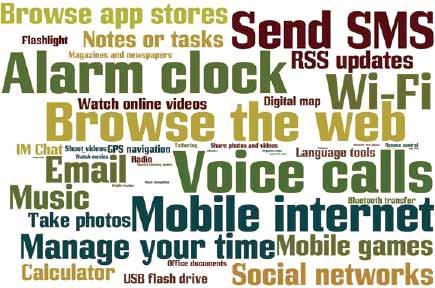
4 minute read
21st Century Skills: Media Literate Students
My eight year old daughter came home the other day and with much excitement asked to be on Facebook. It’s apparently ‘cool’ because it’s the latest talk among her little IC classmates. Like many parents brought up in the 80’s, I shelve her request among the others for i-pads, ipods, iphones, nanos, blackberries, kindle, PlayStations, DS, and every kind of pad out there. I give my usual firm response of “When you’re 18”. My daughter grumbles something about 18 being incredibly old and walks away. I sigh. For I know very well, that the digital media paraphernalia is almost sure to invade my home, filled with old fashioned board games and dollhouses, way before she is 18. I’d be lucky if we make it until 12. “There’s no escaping,” said Mahmud Shihab, IC’s Educational Technology Program Administrator. “Preschoolers are coming to school already knowing how to use touch screen devices which are top notch technology. Not only that. But they are very demanding when it comes to wanting to use IT.” Many students in secondary school don’t
bother with taking notes and simply take pictures of board notes with their blackberries and ‘bbm’ (send) them to each other. They are what are known as “digital natives” – a term coined by Marc Prensky, an educational technology professional - for babies born in the 90’s when Google was first launched. These children have never heard of a world without internet. Quick to recognize these digital natives entering schools, education administrators across the globe are rushing to incorporate IT into their curriculums. IC is no exception. Last year marks a milestone in the integration of IT into the middle and secondary schools (IT was already integrated in the preschool and elementary school’s PYP program since the late 90’s). No longer is IT taught as a standalone subject but is used as part of the class subjects. IC students have become digital media literate - defined as the ability to access, understand and participate or create content using digital media. Blogs, wikis, podcasts, Google documents, Office Live, and twitter are only a small part of the long array of web tools at IC which promise to make any 70’s and 80’s generation parents shy away. “We had to reach out to our students,” said Shihab. “Using IT makes sense to them. We cannot change them but we had to find a way to change ourselves. We had to incorporate digital media into our curriculum”. The first challenge was training hundreds of technologically “old” teachers in both Ras Beirut and Ain Aar (“old” defined as anyone born in the pre-internet era or in other words over the age of 20) to use the latest web tools. Workshops and intensive training sessions (on going) were launched on campus. Some teachers were sent to workshops and conferences locally and abroad run by the IB, French Embassy, NESA, ECIS, and many others. Before long, teachers began using the web tools in their classrooms. Over the past three years, they launched their own wikis and blogs posting assignments, comments and suggested links. They expected PowerPoint presentations, reports, posters, excel sheets, websites, videos, blogs, podcasts, from their students. Some began ‘tweeting’ their students on latest topic issues. Many reading requirements were emailed instead of printed out. (During the swine flu epidemic in 2009 when some classes were shut down, teachers depended on blogs to keep their lessons going). In the classroom, teachers relied heavily on active boards for their lessons. Students responded. “Teachers saw the response in their students and began teaching each other as well,” added Shihab. The second challenge was integrating IT in the Lebanese curriculum. The school was effectively on its own. Last updated by the government in the early 1990’s, the Lebanese Curriculum calls for minor computer skills and issued a drastically outdated IT book. Fortunately, the IB and the French Baccalaureate programs at IC require a heavy IT application in its curriculum. Teachers in these programs are required to integrate technology quite heavily into their studies. IC took most of these requirements and applied them to the Lebanese program as well. “We are preparing our students for the skills of the 21st century,” said Shihab. “This is what they need to compete in the Lebanese and international career markets. Most jobs today require media literate employees. And these are the jobs that are highly paid. Our students can fit in anywhere and compete.” As the saying goes, a man’s work is from sun to sun but …. an IT’s job technician is never done. The continuously evolving technology means a continuous flow of new web tools and new IT devices (at higher costs!) In the works are multi touch interactive white boards, smart tables, 3D screens and projectors, and many more to come. IC has to keep up. “Students have high expectations from us,” said Shihab. Apparently, so do my two children at home. Despite my resistance to IT devices invading our abode, my little six year old son challenged me. “How come everybody has Wii, iPads and DS and we have none?” he asked. My lecture about using our imagination to play with toys and games falls on deaf ears. I suppose it’s time to admit the ‘digital nativity’ of my children, and head to the nearest IT store.











